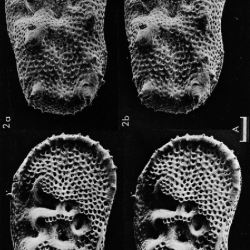Yes, you read that title correctly. Scientists might have just made the case for less unwieldy and enlarged genitalia being superior to cumbersome and grand versions as a means to enhance a species survival. It seems those on the giant genital side of the spectrum, while preoccupied evolving to land a potential mate, might divert their attention away from very real environmental threats for which they have become ill-equipped to handle.
Put simply, exaggerated male sex organs may intensify an organism’s focus so much that they pay a hefty cost when it comes to their own survival. In some cases, facilitating their own extinction.
So says new research published in Nature that extrapolates findings from studying ostracod (or crustaceans) fossils and applies it to humans. The authors contend they may be onto something when it comes to investigating a species intense sexual selection and its relationship to future extinction.
In fact, they conclude:
“We show that species with more pronounced sexual dimorphism, indicating the highest levels of male investment in reproduction, had estimated extinction rates that were ten times higher than those of the species with the lowest investment. These results indicate that sexual selection can be a substantial risk factor for extinction.”
Using ostracod fossils was ideal since males and females have discerning physical traits (e.g. males have “elongated carapaces” that “accommodates the large sperm pumping and copulatory apparatus”). The researchers question the efficiency and expenditure needed for sperm transfer through such a large muscular pump to culminate in ejaculation. They speculate sperm competition could be a hefty burden amounting, in part, to female adaptations that could be counterproductive leading to population level losses.
The authors make the leap to humans here:
“Current extinction risks are heavily shaped by human impacts and their drivers may differ from extinctions in pre-human ecosystems. Nevertheless, if costly male traits increase extinction risk by decreasing the capacity of populations to respond to changing conditions, this mechanism could also operate in present-day populations and thus compound risks…”
What’s the bottom line?
According to this team of paleontologists and evolutionary biologists, striking the balance between perpetuating a species and contributing to its demise involves more moderate to reduced size male sex organs. Or, at least a more moderate or diminished preoccupation with male investment in reproduction. Healthy approaches to most things tend to involve more middle-of-the-road mechanisms - consider more balanced eating, sleeping and exercise routines. Why should sex be any different? If sex exclusively is on the brain at the expense of all other human investments, then other aspects of life will assuredly be underdeveloped. This may or may not lead to extinction, but it will routinely cause problems, some more damaging and irreparable than others.
Source(s):
Maria João Fernandes Martins, T. Markham Puckett, Rowan Lockwood, John P. Swaddle & Gene Hunt. High male sexual investment as a driver of extinction in fossil ostracods. Nature (2018). (doi:10.1038/s41586-018-0020-7)
Hanna Kokko. When sex differences lead to extinction. Nature, 11 April 2018. (doi: 10.1038/d41586-018-04059-7)
Giant genitals were the downfall of some ancient crustaceans. Nature, 11 April 2018.

